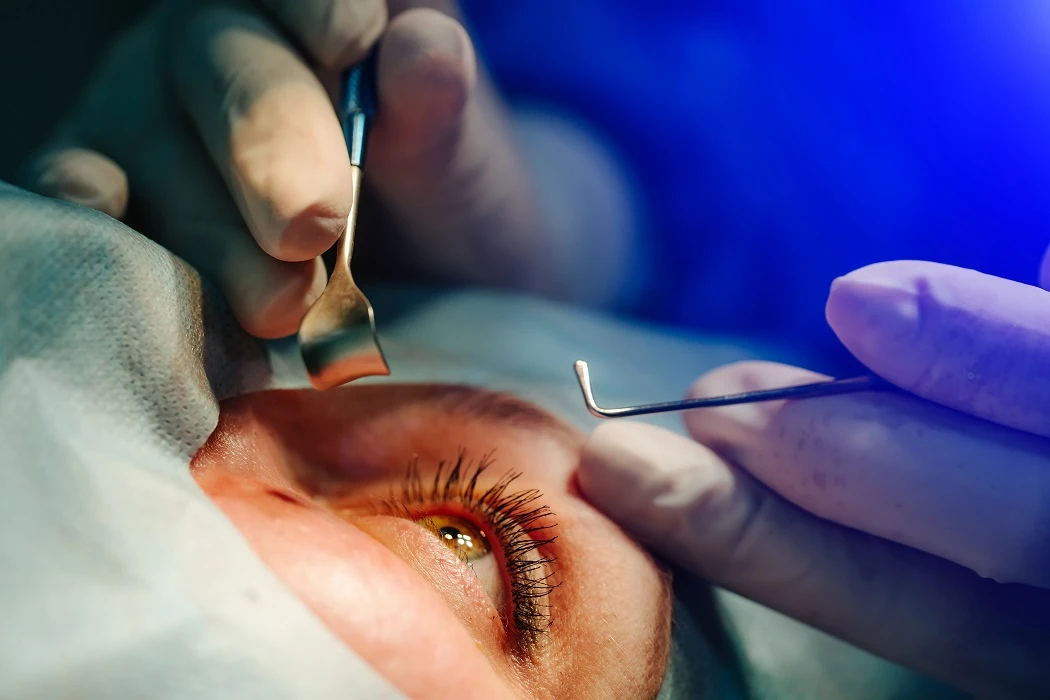A trusted guide to restoring clarity, comfort, and confidence in your vision.
What Is a Cataract?
A cataract is the clouding of the eye’s natural lens, leading to blurry vision, increased sensitivity to glare, faded colour perception, and difficulty seeing at night. While cataracts most commonly occur due to aging, they can also be caused by genetic predisposition, diabetes, prolonged exposure to ultraviolet light, trauma, or long-term use of medications such as steroids. Over time, as the cataract progresses, everyday activities like reading, driving, or watching television may become increasingly difficult even with updated glasses.
Symptoms of Cataracts
The onset of cataracts is gradual and may go unnoticed until vision becomes significantly impaired. Common symptoms include:
- Blurry or cloudy vision
- Increased glare and halos around lights
- Difficulty seeing at night or in dim light
- Frequent changes in eyeglass prescription
- Colours appearing faded or yellowed
If you notice any of these changes in your vision, it may be time for a comprehensive eye examination.
Types of Cataracts
Cataracts can develop in various parts of the lens and due to different causes:
- Nuclear Cataracts: Develop in the center of the lens and may cause the nucleus to appear yellow or brown.
- Cortical Cataracts: Wedge-shaped opacities that form at the outer edges of the lens.
- Posterior Subcapsular Cataracts: Form at the back of the lens and tend to progress faster.
- Secondary Cataracts: Result from diseases like diabetes or long-term use of medications such as steroids.
- Traumatic Cataracts: Develop after an eye injury, sometimes taking years to appear.
- Radiation Cataracts: Occur after exposure to radiation therapy.
- Congenital Cataracts: Present at birth or during infancy; less common but may require early intervention.
How Is Cataract Surgery Performed?
Cataract surgery is a safe and highly effective day-care procedure. At Khetarpal Hospital, we use advanced phacoemulsification and femto-assisted laser cataract surgery techniques that ensure bladeless precision, minimal discomfort, and rapid recovery.
The process involves two main steps:
- Removal of the Clouded Lens: Through a tiny incision, the cataract is gently broken up using ultrasound or laser and removed from the eye.
- Intraocular Lens (IOL) Implantation: A clear, artificial lens is inserted to restore sharp, focused vision.
Most patients experience noticeable improvement in vision within 24–48 hours, with full recovery occurring over a few weeks.
Types of Lens Options Available
Choosing the right intraocular lens (IOL) is an important step in achieving your visual goals post-surgery. Options include:
- Mono-focal IOLs: Provide clear vision at one distance (typically for distance vision).
- Multi-focal and Tri-focal IOLs: Offer vision correction for near, intermediate, and far distances, reducing dependence on glasses.
- Toric IOLs: Designed for patients with astigmatism, improving both clarity and focus.
- EDOF (Extended Depth of Focus) Lenses: Provide a continuous range of vision with fewer halos and glare.
Our team will guide you through the selection process based on your eye health, lifestyle needs, and expectations.
Cataract Surgery vs. Refractive Lens Exchange (RLE)
While both procedures involve the replacement of the eye’s natural lens with an artificial one, their purposes differ:
| Feature | Cataract Surgery | Refractive Lens Exchange (RLE) |
| Purpose | Removes a cloudy cataract lens | Corrects vision before cataracts form |
| Ideal For | Patients with vision-impairing cataracts | Patients with presbyopia or high refractive errors |
| IOL Options | Mono-focal, Multifocal, Toric, EDOF | Multifocal, Toric, EDOF |
| Outcome | Restores clear vision | Reduces glasses dependence & prevents future cataracts |
| Recovery Time | 1–2 weeks | 1–2 weeks |
Both surgeries are highly effective, and the choice depends on your age, vision needs, and overall eye condition.
Other Age-Related Eye Treatments at Khetarpal Hospital
Our expertise extends beyond cataract surgery. We also provide advanced diagnosis and treatment for:
- Diabetic Retinopathy
- Macular Degeneration
- Glaucoma
- Corneal Surgeries
- Refractive Lens Exchange (RLE)
Each condition requires timely attention, and early intervention is key to preserving long-term eye health.
Take the Next Step – Schedule a Consultation
If you’re struggling with blurry vision, glare, or find yourself constantly updating your glasses, cataract surgery or refractive lens exchange may be the solution you need. These procedures are safe, quick, and life-enhancing.
Book a consultation with Dr. Pooja Khetarpal at Khetarpal Hospital to explore your options for clear, confident vision.
[Schedule an Eye Surgery Consultation →]
Frequently Asked Questions (FAQs)
Does cataract surgery hurt?
No, cataract surgery is typically painless. It’s performed under local anesthesia, and while you may feel slight pressure, most patients report no discomfort.
How do I know if I need cataract surgery?
If you’re experiencing blurry vision, glare from lights, or difficulty with daily tasks like reading or driving, an eye exam can confirm whether cataracts are the cause and whether surgery is advisable.
Is retina treatment painful or risky?
Most retina procedures, such as laser therapy or injections, are minimally invasive and performed under local anesthesia. When performed by specialists, the risks are low, and outcomes are highly favourable.
Is refractive lens exchange safer than LASIK?
For older adults, especially those with presbyopia or high refractive errors, RLE may be a more suitable option. It avoids the corneal risks associated with LASIK and offers a permanent solution.
How long does it take to recover from RLE or cataract surgery?
Most patients return to normal activities within 24–48 hours. Full visual recovery typically occurs over a few weeks, depending on the individual’s eye condition and lifestyle.



